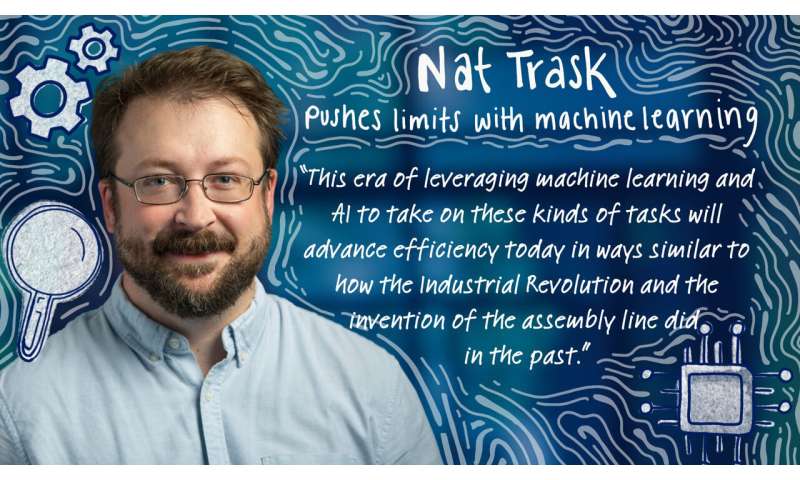Pushing the limits of scientific discovery with machine learning

What if scientists and policy-makers could automate and optimize the filtering of the massive amount of data available across each system they interact with to pull out information that could help humans solve problems across issues including food security, personalized health care, climate change and more? With machine learning, we just may be able to.
This revolutionary tool holds the potential to extend human intuition and recognize patterns in places we would otherwise not have thought to look. And, it is likely in those places where we will find innovative solutions to some of our most pressing issues. Machine learning can already help us decipher large amounts of data in short amounts of time, now it's up to us to figure out how to apply it.
Nat Trask, Associate Professor in Mechanical Engineering and Applied Mechanics (MEAM), is combining his expertise in applied mathematics and traditional physics modeling with the powers of machine learning to uncover an abundance of applications through what he calls "self-driving labs."
With a Ph.D. in applied mathematics, Trask started his research career consulting on projects in computational fluid dynamics. He soon joined Sandia National Laboratories and began working on a myriad of systems governed by complex physics such as fusion power, shock physics, semiconductor physics, 3D printing and material discovery.
In the last five years, he made a drastic shift in his research, changing his focus to machine learning for scientific modeling. Recognizing that the applications of machine learning were endless, Trask joined Penn Engineering with new research goals in mind.
"The problems we focus on at Sandia are so complex that traditional modeling alone lacks the ability to make accurate predictions," he says. "There are just too many different kinds of physics and length scales at play."
That's when his idea of the self-driving lab was born.
"A self-driving lab is like a self-driving car," says Trask. "In the car, AI tells a mechanical system what to do based on the incoming information and the parameters of the system. In a self-driving lab, AI would tell robots to perform certain experiments in a certain order based on the data it is receiving. There might be a thousand experiments running at one time, each providing different insights from large datasets."
Trask aims to design some of his first machine-learning-powered, self-driving labs at Penn. These labs would allow researchers from different fields to discover new patterns and connections across their work and help drive innovative solutions in medical diagnosis and treatment, energy storage, sustainable material discovery and more.
"This era of leveraging machine learning and AI to take on these kinds of tasks will advance efficiency today in ways similar to how the Industrial Revolution and the invention of the assembly line did in the past," he continues. "By applying these tools to advance scientific discovery, we could access a new kind of throughput, much faster and across all scales."
And Trask is already using the power of machine learning in his own work to produce more accurate physics models.
Traditionally, physics modeling has been done by studying individual interactions at each scale, from atoms to molecules to millimeter-scale materials and so forth. These observations, paired with restrictive assumptions, produce relatively simple models that don't apply to every scenario. By using machine learning, these interactions can be observed and understood at a higher resolution.
"Now, we can plug one example of interaction at each size scale into an algorithm and have it do the hard work of identifying useful information," says Trask. "It can apply the known laws of physics, such as 'f=ma,' and then inform a model of how matter will interact across these scales. By removing the limitations of our own human cognition in this approach, we also remove the restrictive assumptions applied in previous approaches and produce a more accurate model."
From building more accurate physics-based models to developing automated experiments that support self-driving labs, Trask sees Penn as the perfect place for collaboration and the freedom to experiment.
"Sandia has great experimental facilities to develop AI that can usefully tell us what experiment to do next, but universities are a better place to perform risky research and rapidly develop new ideas," says Trask. "That is why I joined Penn. Penn Engineering is known for world-class experts in autonomous robots, medical devices, materials science and more, and these are the types of people I want to work with to apply machine learning and self-driving labs to real, societally-relevant problems."
Trask has already begun establishing relationships across and beyond Penn to address these problems. As the co-director of a Department of Energy-funded Mathematical Multifaceted Integrated Capability Center called SEA-CROGS, Trask is working with six other universities and two national laboratories to develop next-generation scientific machine learning architectures to address needs in high-consequence engineering settings such as improving the analysis of climate systems and identifying early warning signs of extreme weather.
In addition to running SEA-CROGS, Trask is building up his own lab and launching some of his first collaborative projects at Penn.
"This is an exciting time for me and the field of machine learning overall," says Trask. "This fall, my group is moving into Amy Gutmann Hall, kicking off many collaborative projects and inviting faculty and students to get involved in new work developing some of the first self-driving labs at Penn. We are at the forefront of creating the standard of physics-informed machine intelligence, and those who are working on these questions now could be the first to do it right."
Provided by University of Pennsylvania